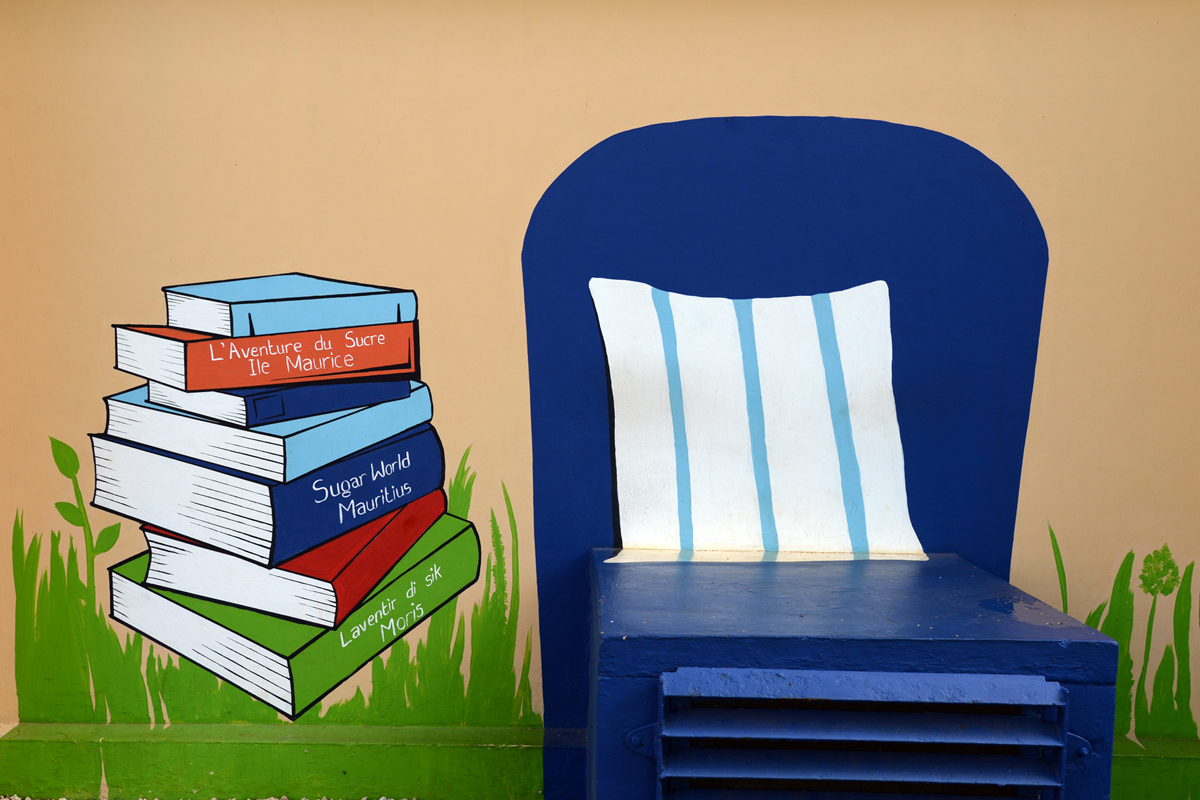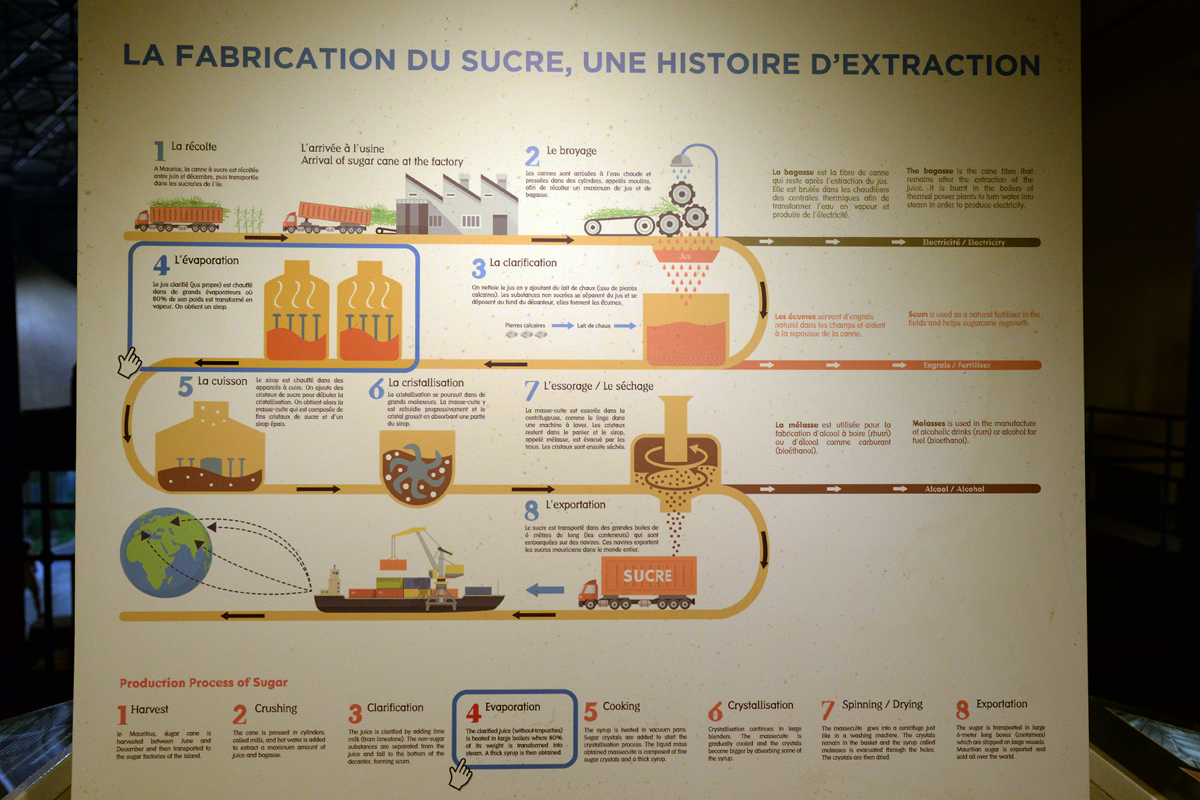
Recently I visited one of the most impressive museums I have seen in a long time - L'Aventury du Sucre, situated in the north-western corner of Mauritus in the district of Pamplemousses. This visit turned out to be a superb interactive guided tour of the history of sugar which is closely linked to the history of the island and the people who make up this multiethnic nation. The museum has been an absolute highlight of my visit to Mauritius. I did a guided tour together with a young couple from South-Africa, lasting one and a half hour. We went «wow» several times during the tour that ended with a tasting of 11 varieties of unrefined sugars. The tasting including also tasting of rum. I never knew sugar could come in so many different colors and with such difference in taste!

Sugar has had a profound impact on the development of the island. It has played a major role on the economy ever since sugar canes were introduced by the Dutch colonists in the 1600s. This sugar adventure lasted for aprox. 250 years and led to the building of factories spread around the island. In a way you can say that Mauritius was founded on sugar. Sugar canes are still grown today, but there are only 3 factories still in operation. Through the heydays of sugar, there were up to 300 factories. The decline was due to factors like defleated prices, competition, demands and later centralization.


The museum is situated in the former sugar factory Beau Plan Sugar Estate, that had been an operating factory for 177 years when it closed in 1998. The chimney is round. The guide told us that there are only two round chimneys on the island. All of the rest are square. The museum is impressive both on the outside and the inside. The factory has been restored and most of the original machinery is still here. When you follow the exhibitions around the place, you will have lots of informative boards, photos and films. I took the photos with my camera and because of the darknes and artificeal light, the quality isn't too good. High ISO and the built-in flash doesn't do justice to the place. I will start at the beginning with the information the guide provided along with the boards.


Our guided tour started in a room showing a film with vulcanic eruption to illustrate how the island was formed. Then a brief introduction to the history of this young nation (400 years). There were no inhabitants on the island when the Arabs discovered the island in the 15th century.

The harbour of Port Louis ( the capital)

We then entered one of the larger halls. A wooden barge is placed here. It was still in use up until the 1970s and is the only one left on the island. Because the water level in the harbour of Port Louis was low, they had to use this kind of flat bottomed barges to carry the sugar to the larger ships. Our tour continued into the history of sugar around the world and how it ended up becoming a product only used by kings to an everyday product for all of us.


The history lesson continued. The Dutch arrived in 1598, but they were busy with the spice trade in Java (Indonesia), so they didn't have time to become interested in colonizing the island before 1638. When they came back, they brought with them sugar canes from Java and Mauritius became a port-of-call for the Dutch. This was the start of the sugar adventure in Mauritius, named after the Dutch prince Maurits of Nassau.

The Dutch abandoned the island in 1710 to concentrate about their efforts on the Cape. During the period 1715 - 1764 the island was under the adminestration of French East India Company. The name of the island was changed to Ile de France. But it wasn't until 1735 that they really got interested in the island.



The development of the colony started for real when the French and then the British took over. In order to provide workers to work on the sugar plantations, slaves were transported from East Africa. On one of the sign boards I read that in 1766 when the island was under control of the French king, the island had 20.098 inhabitants. This included 1.998 «white free men» and 18.100 slaves. The development of Mauritius as a colony was for a long time built on slavery. In 1835 slavery was abolished. Britain introduced indentured labourers to work on the plantations. Between 1830 – 1910 more than 462.000 of these indentured labourers arrived Mauritius. The majority came from India. We were told that they worked on 5 year contracts and didn't get payed before after 5 years. Some died before the end of the contract, but many stayed. Today more than half of the population are of Indian origin, due to this amount of indentured labourers.




We have now been through the history of the island which became independent in 1968. We enter a large, two storry hall that took us through the different stages of the production prosess from the sugar canes arrives and to the finished product – sugar. Informative boards are placed all the way around the machinery, so that you know where you are in the prosess. What can not be seen in the photographs is that the large gears were slowly moving.



At this point the guide asked us what we think is the reason why the 19 different types of sugar on Mauritius have different colors and taste. We guessed at 19 different sugar canes. But that was not the right answer. It is during the process that it happens, by choosing different temperatures etc.





Our tour is almost complete. We end up almost where we started. At the wooden barge. This time we enter. Inside there is an exhibition with old photos of the workers carrying sacks of sugar on board. This is meant as a tribute to the dockers.



These maps shows how much of the island was lush tropical forest (dark green) and how much was used for growing sugar canes (light green) in the period from 1770 – 1950. Almost all of the island.

Our tour ended in the gift shop with sugar and rum tasting. There are jam and honey as well, but I preferred the sugar. Actually I ended up buying some. After the guided tour had come to an end, I went in again, to get time to read more and check the films and the art exhibition on the first floor. This is a place where it's easy to spend at least 3-4 hours. That's what I did. Certainly an informative visit, that I can highly recommend.
Another excellent musuem is Apravasi Ghat in the capital Port Louis. It is on UNESCO's Heritage List and of historical significanse as an immigrant depot for indentured labourers who arrived to work on the sugar plantations.
Sources:
Guide on tour and written information in the museum.
Please do follow if you want to keep up with my next travel story. Any upvotes or reblogs are hugely appreciated!
Latest travel stories, check out :
Denmark - Childhood memories
U.J
Kristiansand, Norway
All the photoes are mine, Ulla Jensen (flickr, Instagram and facebook)
[//]:# (!pinmapple -20.109009 lat 57.580071 long Mauritius - The story about how the sugar adventure is linked to the history of the island d3scr)
Read about us? // Main page!
Latest content: Travel, Art, Article, Poetry





















 At this point the guide asked us what we think is the reason why the 19 different types of sugar on Mauritius have different colors and taste. We guessed at 19 different sugar canes. But that was not the right answer. It is during the process that it happens, by choosing different temperatures etc.
At this point the guide asked us what we think is the reason why the 19 different types of sugar on Mauritius have different colors and taste. We guessed at 19 different sugar canes. But that was not the right answer. It is during the process that it happens, by choosing different temperatures etc.










Your content has been voted as a part of Encouragement program. Keep up the good work!
Use Ecency daily to boost your growth on platform!
Support Ecency
Vote for new Proposal
Delegate HP and earn more
Thank you so much :)
Congratulations, your post has been added to Pinmapple! 🎉🥳🍍
Did you know you have your own profile map?
And every post has their own map too!
Want to have your post on the map too?